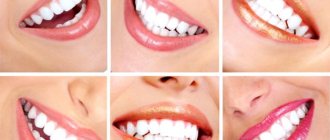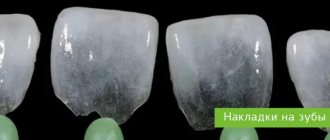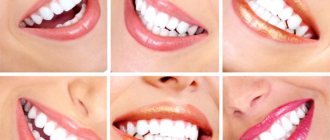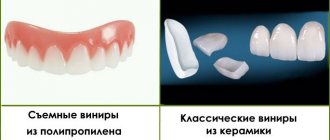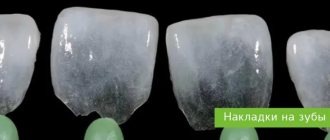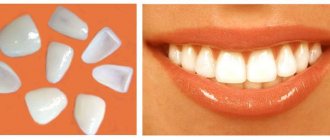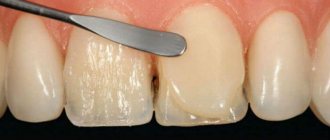12.06.2018
962
- 1 Materials used
- 2 Manufacturing stages
- 3 Layer-by-layer method
- 4 Casting method (injection pressing)
- 5 Computer modeling
Veneers are thin shells that are placed on the front of the tooth. They allow you to hide various external imperfections of the dentition and make your smile beautiful and mesmerizing. With their help, you can correct irregular tooth shapes, eliminate chips, change color and much more. Below we will take a closer look at how veneers are made and what materials are used for this.
Materials used
Ceramics and filling material are used to make veneers.
There are two types of ceramics - porcelain and zirconium dioxide. Porcelain is very similar to natural tooth enamel; it is highly durable, does not change color even after a long time, and is translucent. Thanks to this, overlays made of this material look very natural and natural, even if you look at them from a close distance. Zirconium dioxide overlays have a long service life and high reliability. They do not absorb food dyes and do not fade over time. Filling material is what veneers, called composite, are made from. They are performed directly in the dental office. As a rule, such dentures are installed on the front teeth without grinding them down.
The cost of composite veneers is lower compared to ceramic ones, but they deteriorate faster and are not able to last a long time.
In addition, there are so-called lumineers - ultra-thin veneers made of very durable porcelain, whose thickness is only 0.2-0.5 millimeters. They do not affect the enamel and can be removed if desired. There is no need to grind down your teeth before installing lumineers; they are secured using a mixture that does not dissolve in saliva.
Composite veneers
Composite dental onlays are much cheaper than ceramic ones because they are installed in one appointment, right in the dentist’s office. The surface of the tooth is prepared before installation, and then the doctor applies the composite material step by step, layer by layer. In essence, this is a large filling for the entire tooth. Composite overlays are not as durable as ceramic overlays and are prone to dulling and microcracks, so they need to be polished regularly. Usually used for the restoration of one tooth or several located in different places.
Manufacturing stages
The structure is installed exclusively on healthy teeth. Therefore, you should first remove tartar and small cracks, get rid of gum defects, and also cure caries. Otherwise, dangerous diseases may subsequently develop under the veneer.
In addition, before manufacturing and installing the structure, perform the following steps:
- The enamel surface must be cleaned of food debris and plaque. In this case, special products are used that do not contain oil and fluorine, since they can cause harm;
- Select the desired color of the filling material based on the shade of the adjacent teeth;
- The anterior tooth surface is ground under local anesthesia. To do this, a certain amount of hard tissue is eliminated and a smooth transition to the cervical area is created.
After the preparation is completed, you can begin making the impression. To do this, an impression tray with a special silicone mass is pressed against the teeth and fixed for several minutes. The solution hardens and the shape of the teeth is imprinted on it.
The made impression is sent to the laboratory, where specialists use it to create an accurate plaster model of the teeth. Below we will take a look at how veneers are made using various methods.
Contraindications
Contraindications are the same as for conventional veneers:
- diseases of the teeth and gums (caries, pulpitis or periodontitis);
- significant bite defects;
- bruxism - involuntary grinding of teeth during sleep;
- tooth mobility;
- significant destruction of the crown of the tooth.
Layer-by-layer method
In this method, plates are made from platinum foil, whose thickness is 0.020-0.025 millimeters.
The foil is pressed around the prepared tooth on a plaster model. The specialist applies ceramic mass to the model and fires it. The foil holds the ceramics during the firing process, which prevents possible distortion and loss of the desired shape. The model is then sanded and finishing touches are made so that the veneer can be seated on the intended tooth without any problems. This technique is economical because it does not require the use of expensive platinum foil. Therefore, manufacturing the structure will not cost a lot of money.
Modern veneers in dentistry
Thick plates requiring serious tooth grinding are almost a thing of the past. A modern veneer is a very thin plate of durable ceramic, the thickness of which does not exceed 0.2-0.4 millimeters. Some veneers are almost as thick as eye contact lenses. Such a small thickness was achieved thanks to improved ceramic masses, which are highly durable. Now even a very thin veneer will not crack, unless, of course, you try to chew on a glass bottle or a piece of concrete.
Most often, veneers are classified as aesthetic dentistry because they allow you to perfectly adjust the color and shape of your teeth. However, veneer, being a microprosthesis, also solves functional problems - to hide chips and cracks in the enamel, to remove slightly enlarged spaces between teeth, to hide pigment spots. The veneer also serves as protection for the tooth, since ceramics are not subject to abrasion, unlike tooth enamel. It is much more difficult for plaque and bacteria to gain a foothold on ceramics.
Installing veneers can also significantly rejuvenate the face - they will restore the height of the teeth, like in young people, and will serve as a framework for the soft tissues of the face, which to a certain extent will prevent the appearance of wrinkles and sagging skin. However, if conventional veneers are so successful in the aesthetic and functional restoration of a smile, then why are refractor veneers needed?
Casting method (injection pressing)
With this technology, a wax overlay of the required shape is made onto a plaster tooth model, which is then treated with a glass-ceramic solution and packed into a special fire-resistant mass.
- Under the influence of high temperatures, the wax melts and is burned out in a vacuum.
- The resulting plate is painted in a color that fully matches the color of the enamel and sanded.
This method is simple to implement and allows you to obtain a highly durable prosthesis and an excellent aesthetic effect.
Watch a video about installing veneers
Notice
: Undefined variable: post_id in
/home/c/ch75405/public_html/wp-content/themes/UltraSmile/single-item.php
on line
45 Notice
: Undefined variable: full in
/home/c/ch75405/public_html/wp-content /themes/UltraSmile/single-item.php
on line
46
Rate this article:
( 1 ratings, average: 5.00 out of 5)
veneers
Computer modelling
This technology makes it possible to make overlays in the shortest possible time directly in the presence of the patient.
True, this can only be realized if dentistry is equipped with expensive, latest technology. A 3D scanner is used to produce the model. Using a specialized program, the computer models the shape of the prosthesis and transmits data directly to a milling device, on which a veneer is milled from a conventional block of ceramic material within ten minutes. Dental veneers are ground, glazed in an oven without a vacuum, painted if necessary, and fixed to the tooth.
A similar method for producing veneers can also be applied remotely. The doctor prepares the tooth and mails the resulting optical impression to the dental laboratory, where the veneer is made and sent to dentistry.
The main advantage of the presented technology is that milling, fitting and fixation of dentures on the teeth can be done in one go.
Today, computer modeling is especially often used in the manufacture of zirconium plates, which are considered the most reliable and prestigious of all.
When to install veneers on teeth
- for small chips of enamel,
- with curvature of the position of the teeth, but minor,
- if there are gaps in the row,
- in general, when the condition of the enamel is unsatisfactory - if it is weakened or has a dark shade that cannot be eliminated through the classical whitening procedure.
If the damage to the tooth is more serious, that is, if it is destroyed by more than 50%, affected by caries, or has large fillings on the front surface, veneers will not save you. In such cases, full prosthetics are required - for example, with crowns.
Chips on teeth - indications for restoration
Recovery and rehabilitation period
You should not eat until the anesthesia wears off after the veneers are installed. Don't bite or chew anything. Also, after the procedure, a combination of taking hot and cold together is not recommended.
You should definitely come for a preventive examination. Your doctor should schedule a date for you to check that your teeth are aligned correctly.
If you have problems such as bruxism or malocclusion, you should wear special protective mouth guards. Also, do not neglect preventive examinations. Another important point is that after installing veneers, you should periodically perform oral hygiene (2 times a day or after each meal).
Care
Ceramic veneers require the same care as natural teeth. To preserve their aesthetics and extend their service life, it is recommended:
- reduce the consumption of foods with dyes (the linings will not change color, but the fixing cement may);
- wear a plastic mouthguard for bruxism - pathological grinding of teeth;
- do not subject teeth with veneers to increased stress (do not bite ice, do not open bottles, do not bite nails and hair ends, do not shell seeds);
- Do not miss dental checkups (once every six months).
Advantages and disadvantages
Advantages:
- high aesthetic effect (ceramics differs from composites in that it retains its original color and, with high-quality processing, is no different from a real tooth);
- biocompatibility (ceramic veneers are hypoallergenic);
- durability (compared to composite onlays, the short-term whitening effect and the five-year service life of a conventional filling);
- minimal or zero treatment of the tooth (the tooth is ground much more strongly for a crown).
Flaws:
- high cost (restoration with composite materials is cheaper);
- instability to heavy loads (can peel off and break);
- irreversibility of the preparation (the tooth ground under the veneer will no longer be able to function normally after the onlay is removed).
How to navigate the names
When choosing records, first of all look at:
- material – ceramics, zirconium, plastic, composite;
- thickness – the method of preparing a dental unit depends on it; the thinner the model, the less turning;
- manufacturer - give preference to a well-known brand whose products are reliable, safe, and time-tested.
In most cases, onlays are placed in the smile area - on the incisors, canines, and premolars. But they can also be fixed to molars. If the tooth is severely damaged, the standard option is not suitable. In this case, the product is installed 180° or 360°, covering the crown on all sides.
What is a classic veneer
This is the name for plates that are fixed only at the front. To attach them, the tooth is ground down, removing the enamel and part of the dentin (hard tissue). This is explained by the fact that:
- The structure of the enamel prevents high-quality adhesion, so it must be removed.
- Dentin needs to be prepared if the thickness of the plate is more than 0.5 mm. Otherwise, the bite will be disrupted, the shape of the face will change, and the patient will feel discomfort.
When you don’t want to sharpen your incisors, canines and molars too much, take lumineers. To fix them, only the enamel is removed.
How to properly care for veneers?
In order for veneers to last as long as possible, you need to follow simple rules for caring for them, namely:
- The veneers are cleaned like regular teeth, using a toothbrush and dental floss. The plates are not subject to accumulation of plaque or the occurrence of caries, but this threatens the teeth, some of which remain uncovered.
- No matter how strong the crowns are, they still remain fragile. Their main task is to improve the aesthetic appearance of teeth. You will have to change your diet and eliminate strength training. These plates should not be used to bite nuts or nails, open bottles, etc. This will lead to their displacement or breakage. It is worth removing foods with natural or artificial colors from food, and significantly reducing the amount of coffee, wine or tea you drink.
- The surface of used ceramics can change under the influence of acid-containing products.
- Ceramics are poorly affected by toothpastes that are highly abrasive or have a low pH content.
- Regular visits to the dental office. At the appointment, the doctor must examine the condition of the veneers and exposed areas of the teeth, as well as carry out professional oral hygiene.
The attending dentist who installed the veneer plates will tell you more about the care. Only he knows the characteristics of the patient’s teeth, their condition and which veneers were used.
Sources used:
- https://www.dentsplysirona.com
- “Criteria for evaluating composite dental restorations” (Nikolaev A. I.)
- “Direct veneers of anterior teeth” (Salova A.V.)
What are veneers and why are they needed?
Veneers should be made to restore the aesthetic appearance of your smile. It is better to place them in pairs so that the teeth look the same. The pads look like real ones. You can install up to 10 teeth on both jaws.
Dental veneers are a type of prosthetics that covers the front part of the tooth. As a result, it looks much more aesthetically pleasing.
Veneers are needed if:
- not satisfied with the natural color of your teeth;
- restoration of the integrity of the enamel is required;
- you need to change the size and shape of the tooth;
- Correction of enamel abnormalities is required (for example, if there is hypoplasia);
- to eliminate interdental spaces.
Veneers mask any imperfections, making your smile beautiful.
